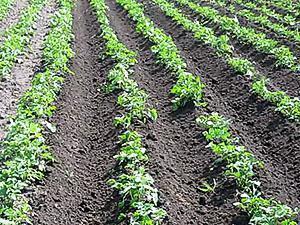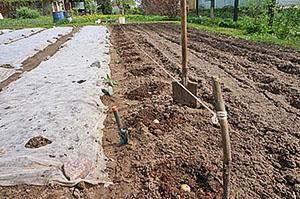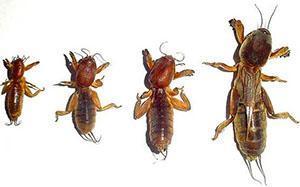Why don't potatoes come up?
 If the weather is warm, and the soil has warmed up under the rays of the sun up to 8-10 C °, the first shoots of potatoes appear on the plantation in about 10-12 days. However, in protracted springs, when May suffers from a lack of sunny days, and the atmospheric thermometer does not rise above + 20 ... +22 C °, the sprouts need a little more time to break through the layer of earth and please the summer resident with their height. Under such conditions, they appear on the surface not earlier than after 20-25 days.
If the weather is warm, and the soil has warmed up under the rays of the sun up to 8-10 C °, the first shoots of potatoes appear on the plantation in about 10-12 days. However, in protracted springs, when May suffers from a lack of sunny days, and the atmospheric thermometer does not rise above + 20 ... +22 C °, the sprouts need a little more time to break through the layer of earth and please the summer resident with their height. Under such conditions, they appear on the surface not earlier than after 20-25 days.
Be sure to ask experienced gardeners or agricultural specialists how many days potatoes emerge after planting directly in the climatic zone where you live and plant the prepared tubers. For example, for the southern regions, the onset of phase 1 (emergence of seedlings) in 20 days is in most cases a deviation from the norm, but for the northern regions this period is quite acceptable.
But, unfortunately, it also happens that all the deadlines pass, and there are still no green rows in the garden. Anxiety and related questions involuntarily arise. Why don't potatoes come up? What prevents him from gaining the strength of growth? What to do: wait for shoots or plant again?
The reasons why potato shoots do not appear
1. Weather conditions

- Freezing. With a sharp drop in temperature, tuber tissues die off. Buds and matured shoots also get cold burns: without a "pantry of nutrients" they quickly die or drastically slow down growth (with partial damage).
- Increased soil moisture. Abundant precipitation during the first phase of the growing season leads to decay of the planting material.
- Drought. Without moisture, the development of shoots on the root crop is inhibited or stopped altogether. (Even with the required amount of micro and macronutrients!)
2. Diseases and pests
 Only planted potatoes are a tasty morsel for insect pests that live in the soil that have woken up after hibernation. Among the most notorious types of malware:
Only planted potatoes are a tasty morsel for insect pests that live in the soil that have woken up after hibernation. Among the most notorious types of malware:
- Medvedka, or cabbage.
- May beetle larva (furrow).
- Wireworm (larvae).
They are especially gluttonous: they make moves in the tubers, gnaw at the sprouts. Living in large quantities on the site, they can destroy up to 80-100% of seed tubers.
 Various fungal diseases also prevent the emergence of seedlings:
Various fungal diseases also prevent the emergence of seedlings:
- late blight;
- rhizoctonia (black scab);
- gray spot
- potato cancer
- dry rot, etc.
3. Incorrect storage of seed
 Inexperienced or unscrupulous preparation of tubers for planting reduces the percentage of their germination by 50-100%. In order to avoid such an extremely negative result, it is strictly prohibited to:
Inexperienced or unscrupulous preparation of tubers for planting reduces the percentage of their germination by 50-100%. In order to avoid such an extremely negative result, it is strictly prohibited to:
- store tubers in plastic (polyethylene, polypropylene) bags;
- do not sort them before planting (do not select damaged and infected tubers);
- do not germinate;
- prepare tiny tubers for planting (less than 15-20 g);
- treat with fungicides / insecticides and growth stimulants, increasing the consumption rate;
- use potato varieties that are poorly adapted to the climatic conditions of the region.
If there is a need to buy potato seeds, in no case should you go to a supermarket or a grocery store for them.Tubers intended for human consumption, as a rule, are treated with a special chemical solution so that they retain their presentation for a longer time and do not sprout.
How to achieve high germination of potatoes?
 Go through potatoes: reject diseased and damaged (bruised, chopped) tubers.
Go through potatoes: reject diseased and damaged (bruised, chopped) tubers.- Place the seed in shallow boxes (ideally in one layer). And then place them for 2.5-3 weeks in a well-lit room in which the air temperature is not less than 15 ° C.
- During the entire vernalization (germination) stage, spray the tubers with water at intervals of 6-7 days.
- Consider the weather conditions when choosing a day to plant potatoes.
Experienced gardeners recommend that in the process of plantation plantation be guided by the rule of "three dozen", or three signs: 10 C ° - soil temperature; 10 cm - the depth of the landing hole; 10 days is the time for shoots to appear. In their words, this is the best recipe for getting rid of the worrying question "why potatoes don't sprout?"
- Immediately before planting, treat the sprouted tubers with copper sulfate (the concentration of the solution should not exceed 2 g per 10 l).
Take these five operations as a mandatory minimum, and the chances of a high yield of potatoes will increase many times over.
When asked why potatoes do not sprout, the author gave an unexpected answer. So, in the first part it is "strictly forbidden" to sort the seeds before planting, to germinate, and not to plant seeds less than 20 grams. The second part, on the contrary, advises to select, germinate, and even treat it with copper sulfate before planting. However, fungicides are treated before vernalization; young leaves on the seedlings can burn out. A full harvest is obtained from small seeds during reproduction.
The potato may not sprout if it is "hardened". This happens if a hasty summer resident threw unsprouted potatoes into the cold ground, and even on the bayonet of a shovel. Until the heat reaches deep into the potatoes, they cannot sprout, and later they lie there, not rotted and not sprouted. If there are sprouts, then even in the boundary state of the soil, the seeds will sprout. Late, but the root will develop. Only the shoots before planting should be complete, with root rudiments. Planting even this material deeply can reduce germination.
Dear Albina Andreevna! The answer seemed to you "unexpected" in view of a cursory acquaintance with it. Criticizing the list of prohibitions, for some reason you omitted the particle of negation "not" in these actions. Namely, do not sort, do not germinate. That is, according to the text: it is impossible to prepare seed without sorting and germination. Where have you seen the “young leaves” on the shoots developing from the axillary buds? And how from a solution of vitriol of such a concentration "can burn", again "leaves"? In general, we are talking about germination, i.e. selection and laying of tubers.
Yes, I agree with you, small seeds produce a good harvest, provided that they gave strong sprouts. But judge for yourself which tuber is more likely to form strong shoots: a stunted "pea" from a marigold or a medium-sized potato. If there is no seed at all, then you can take a chance.
And in the second part ("vice versa" in your words) recommendations are given. Of course, on the contrary, because it tells what needs to be done. The optimum temperature for planting and the degree of readiness of the tuber is popularly said. In addition to "hardened" there are other significant factors. For example, the planting scheme (correct or not?), What soil, NPK balance, etc.
YOU, too, unexpectedly surprised with your competence: "Only the sprouts before planting should be full-fledged, with the rudiments of roots" What are the rudiments of roots ?!
But everyone has their own experience, of course, in the garden business.)) Both positive and negative ... Most importantly, more practice in this matter; certainly with a competent approach and with a focus on the opinion of plant breeders professionally engaged in the cultivation of potatoes and other agricultural crops.
And what to do if it is already the end of June, but he did not sprout, he dug up a couple and on them tubers without sprout.
There is nothing you can do about it, if by summer it has not sprouted, there will be nothing. Maybe you planted too early or too deep, so it froze. If the climate permits, you can try summer planting. They say that she also gives a good harvest.